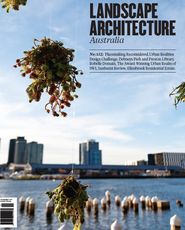This year’s AILA National Conference saw the subtropical heartland of south-east Queensland transformed by new discourses in landscape. The conference line-up boasted keynote speakers from the UK, US and Canada, and a diverse mix of practitioners, planners, scientists, architects, artists and policy changers from within Australia.
Themes that emerged from the conference included the provision of equitable space in the public domain, post-industrial regeneration and the challenge of climate change at both grassroots and large-scale policy levels. Many of the speakers referenced the breaking down of professional barriers and the role of landscape architects in facilitating and empowering the public in the design of our environment.
The structure of the conference allowed us to engage with the city through site tours on the first day, ranging in scale from small interventions in the urban core to major infrastructure projects. The Urban Acupuncture tour took us through Brisbane’s CBD to investigate a number of small projects implemented by Brisbane City Council as part of their city centre masterplan. These projects aimed to create diverse spaces throughout the urban core, providing pedestrian amenity and fostering interactions between people and the urban fabric.

Sarah Gaventa.
The work showed a strategic collaboration between council staff and public artists, demonstrating the role of landscape architects as facilitators of change, a theme that threaded through the conference. Projects like Jacob’s Ladder and Burnett Lane display how ephemeral projects can be embraced by the public, transforming attitudes to overlooked urban spaces. The site tours were an opportunity to explore built projects in the flesh, an important counterpoint to the conference lectures.
The conference was opened by Sarah Gaventa, former director of CABE Space in the UK, calling for a “magic wand” and demanding “better design of public spaces.” She argued for transformation in the role of landscape architects to leaders in green infrastructure, facilitators of change, collectors of evidence and a voice for the public in policy and social reform. Gaventa also generated healthy debate throughout the conference by reinforcing the importance of design for people.
The theme of the designer as facilitator was repeated throughout the conference. Richard Brecknock discussed the facilitator role in relation to public art, Tony Cox outlined the CABE Spaceshaper tool for community consultation, and Greg Gerbash identified the shift in roles from designer as expert to designer as facilitator through his work with Indigenous communities in north-west Western Australia. Gerbash was particularly engaging in communicating the frustrations and challenges of work in remote areas.
Climate change was addressed by a number of speakers with doom and gloom scenarios that saw us living in strange biodomes or vegetated pyramids, balanced by more optimistic and empowering strategies for visualization and adaptation. Stephen Sheppard, the director of CALP at the University of British Columbia, challenged us to “think big,” get training and link up with scientists and experts. In making visual both the risks and the solutions at a range of scales, we can empower local communities and develop a new design language that encourages resilient solutions. Joshua Zeunert, Allen Kearns and Jean Palutikof discussed strategies for adaptation through local food production, risk mapping and education, emphasizing the human scale of climate change.
On the education front Tim Waterman, a lecturer in landscape architecture from the Writtle School of Design in the UK, and Hisham Elkadi, head of architecture and building at Deakin University, opened new avenues for discourse on landscape and cities. Waterman signalled new ways of thinking about landscape across a range of disciplines, from our geological history of 8,000 years to its role as the site of social justice and the development of landscape ethics. Waterman advocated a move to a more inclusive, “holistic approach to landscape which provides a place for everyone thinking ideas about landscape.” Elkadi presented a theory of how cities move and transform with changes to industry, with Geelong as a case study. He presented a strategy for urban renewal initiated by shifting the Deakin University campus to Geelong as the catalyst for change.
Christy Ten Eyck opened the third day of the conference to an audience thirsty for built projects. After much discussion on the role of landscape architect, her theme of the memory of water seemed highly appropriate. Based in the dry landscapes of Arizona and Texas, her body of work captured a conversation between the pragmatic and the aesthetic. Her projects harnessed the qualities that make places distinct – the local plants, topography, climate, and the culture and traditions of its people – to form poetic and beautiful projects built on a firm understanding of natural systems. It was a timely reminder of how landscape architecture can adapt to future environmental challenges and celebrate one of our most precious of resources, water.
Following this range of challenging and engaging speakers it was hard to reconcile the mix of spin and questionable urban planning ideas that occupied other parts of the conference. Perhaps more time during the response sessions would have allowed for some more vigorous discussions. For future conferences the challenge lies in balancing the success of speakers and topics with a rethink on location and carbon footprint, and reducing the waste inherent in catering and advertizing to delegates. Overall the conference delivered a good dose of inspiration from both the diversity of speakers and the local built work.
The 2011 AILA National Conference, Transform, was held at the Brisbane Convention and Exhibition Centre 11–13 August 2011.
Source

Discussion
Published online: 1 Nov 2011
Words:
Linden Crane
Issue
Landscape Architecture Australia, November 2011














